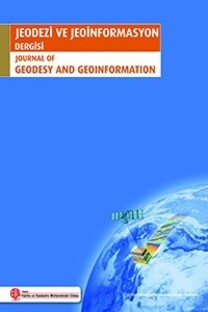Rastgele Orman algoritması kullanılarak çok bantlı görüntülerin sınıflandırılması
Görüntü sınıflandırma, Rastgele orman algoritması, Doğruluk analizi, Arazi kullanımı
Classification of multispectral images using Random Forest algorithm
___
- Aisen B., (2006), A comparison of multi class SVM methods, http://courses.media.mit.edu/2006fall/mas622j/Projects/aisenproject/index.html [Erişim 20 Eylül 2012].
- Akar Ö., Güngör O., Akar A., (2010), Rastgele orman sınıflandırıcısı ile arazi kullanım alanlarının belirlenmesi, III. Uzaktan Algılama ve Coğrafi Bilgi Sistemleri Sempozyumu, 11-13 Ekim 2010, Gebze, Kocaeli, Bildiriler Kitabı, 142-152.
- Archer K.J., (2008).Emprical characterization of random forest variable ımportance measure, computational statistical data analysis, Computational Statistics & Data Analysis, 52(4), 2249-2260.
- Breiman L.,Cutler A., (2005), Random forest, http://www.stat. berkeley.edu/~breiman/RandomForests/cc_home.htm, [Erişim 12 Temmuz 2011].
- Breiman L., (2002), Manual on setting up, using, and understanding random forests V3.1, http://oz.berkeley.edu/users/breiman/ Using_random_forests_V3.1.pdf, [Erişim 20 Eylül 2011].
- Breiman L., (2001), Random forests,machine learning, 2001 Kluwer Academic Publishers, 45(1), 5-32.
- Dronova I.,Gong P., Wang L., (2011), Object-based analysis and change detection of major wetland cover types and their classification uncertainty during the low water period at Poyang Lake, China, Remote Sensing of Environment, 115(12), 3220-3236.
- ENVI, (2005), ENVI’s User Guide, http://geol.hu/data/online_help/ ApplyingMaximumLikelihoodClassification.html, [Erişim 20 Eylül 2011].
- Gao J.,(2009), Digital analysis of remotely sensed imagery, The Mc Graw-Hill Companies, USA.
- Gislason P.O.,Benediktsson J.A., Sveinsson J.R., (2006), Random forest for land cover classification, Pattern Recognition Letters, 27, 294-300.
- Gislason P.O.,Benediktsson J.A, Sveinsson J.R., (2004), Random forest classification of multi-source remote sensing and geographic data, IEEE International Geoscienceand Remote Sensing Symposium IGARSS ‘04Proceedings, 2,1049 – 1052.
- Horning N., (2010), RandomForests : An algorithm for image classification and generation of continuous fields data sets, International Conference on Geoinformatics for Spatial Infrastructure Development in Earth and Allied Sciences (GISIDEAS) 2010, 9-11 December, Hanoi,Vietnam,wgrass.media. osaka-cu.ac.jp/gisideas10/viewpaper.php?id=342, [Erişim 15 Eylül 2011].
- Jay S., Lawrence R., Repasky K., Keith C., (2009), Invasive species mapping using low cost hyper spectral imagery, ASPRS 2009 Annual Conference,March 9-13, Baltimore, Maryland.
- Kaban Z., Diri B., (2008), Genre and author detection in turkish texts using artificial immunere cognition systems, IEEE 16th Signal Processing, Communication and Applications Conference, 20-22 April 2008, http://ieeexplore.ieee.org/stamp/ stamp.jsp?tp=&arnumber=4632548, [Erişim 06 Ekim 2011].
- Kavzoğlu T.,Çölkesen İ., (2010), Destek vektör makineleri ile uydu görüntülerinin sınıflandırılmasında kernel fonksiyonlarının etkilerinin incelenmesi, Harita Dergisi, 144.
- Liaw A.,Wiener M., (2002), Classification and regression by random forest, R News, 2(3).
- Lillesand T. M.,Kiefer R. W. And Chipman J. W., (2004), Remote Sensing and Image Interpretation, Wiley, United States of America, 804 ss.
- Matinfar H.R.,Sarmadian F., AlaviPanah S.K., Heck R.J., (2007), Comparisons of object-oriented and pixel-based classification of land use/land cover types based on lansadsat7, etm+ spectral bands (case study: arid region of Iran), American-Eurasian J. Agric. &Environ. Sci., 2 (4), 448-456.
- Pal M., (2005), Random forest classifier for remote sensing classification, International Journal Of Remote Sensing, 26(1), 217-222.
- Pal M., (2003),Random forest for land cover classification, IEEE International Geoscienceand Remote Sensing Symposium, IGARSS ‘03Proceedings,6, 3510-3512.
- Prasad A.M.,Iverson L.R.,Liaw A., (2006), Newer classification and regression tree techniques: Bagging and random forests for ecological prediction, Ecosystems, 9,181-199.
- Waske B.,Braun M., (2009), Classifier ensembles for land cover mapping using multi temporal SAR imagery, ISPRS Journal of Photogrammetryand Remote Sensing, 64, 450-457.
- Waske B.,Heinzel V., Braun M., Menz G., (2007), Random forests for classifying multi-temporal sar data, Proc. ‘Envisat Symposium 2007’, 23–27 April 2007, Montreux, Switzerland, http://envisat.esa.int/envisatsymposium/proceedings/ sessions/3D3/461589wa.pdf, [Erişim 11 Ağustos 2011].
- Watts J.D., Lawrence R.L., (2008), Merging random forest classification with an object-oriented approach for analysis of agricultural lands, The International Archives of the Photogrammetry, Remote Sensing and Spatial Information Sciences, XXXVII(B7).
- Watts J. D.,Powell S. L., Lawrence R. L., Hilker T., (2011), Improved classification of conservation tillage adoption using high temporal and synthetic satellite imagery, Remote Sensing of Environment 115, 66–75.
- Yavuz H. S, Çevikalp H., (2008), A new distance measure for hierarchical clustering, IEEE 16th Signal Processing, Communication and Applications Conference,20-22 April 2008, Aydin, ss.1-4.
- ISSN: 2147-1339
- Yayın Aralığı: Yılda 2 Sayı
- Başlangıç: 2012
- Yayıncı: TMMOB Harita ve Kadastro Mühendisleri Odası
Deniz GERÇEK, Davut ÇEŞMECİ, Mehmet Kemal GÜLLÜ, Alp ERTÜRK, Sarp ERTÜRK
Atmosferik torklardan elde edilen mevsimsel ve mevsim-içi kutup gezinmesi değişimleri
Michael SCHİNDELEGGER, Johannes BÖHM, David SALSTEİN
Rastgele Orman algoritması kullanılarak çok bantlı görüntülerin sınıflandırılması
Türkiye'deki Astro-Jeodezik uygulamalar için sayısal zenit kamera sistemi
